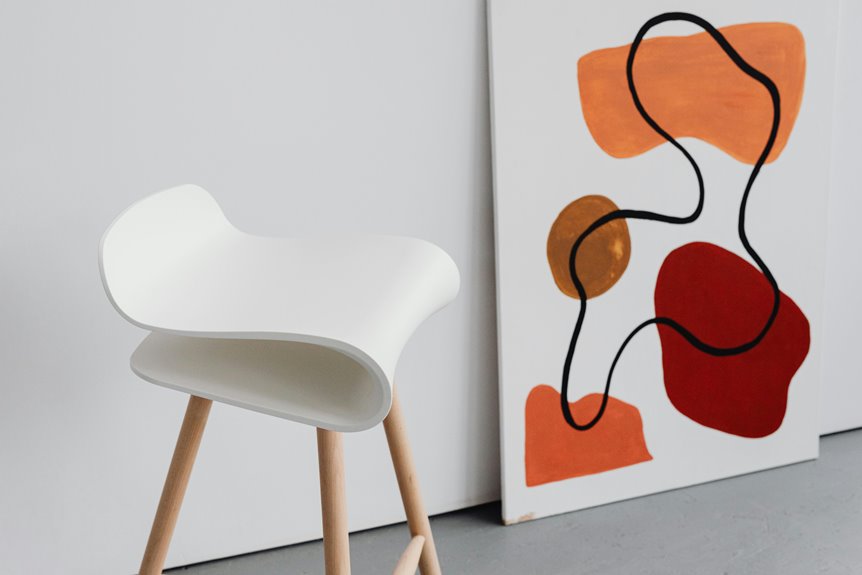When it comes to choosing a chair, understanding how its features support your spine's natural curves is crucial. An ergonomic design can make a significant difference in your comfort during long hours of sitting. You'll want to consider aspects like lumbar support and seat depth carefully. What happens when you neglect these factors? The impact on your posture and overall well-being might surprise you. Let's explore the essential elements that contribute to a healthier sitting experience.
Table of Contents
Key Takeaways
- Built-in lumbar support molds to the lower back's natural curve, enhancing comfort and posture.
- Adjustable lumbar cushions can be repositioned or removed for personalized support.
- A backrest that curves to fit the spine provides targeted support and promotes alignment.
- Deep seat design allows thighs to be supported without restricting circulation.
- Adjustable features like seat height and armrests help maintain natural spine alignment during extended sitting.
Ergonomic Design Principles
When you're choosing a chair for spine support, understanding ergonomic design principles is crucial. An ergonomic chair promotes a natural spine alignment, minimizing strain on your back.
Look for features like adjustable seat height, which allows your feet to rest flat on the floor. A seat that's deep enough supports your thighs without cutting off circulation.
Pay attention to the backrest; it should curve to fit the natural shape of your spine, providing support where you need it most. Armrests can help reduce tension in your shoulders, but they should be adjustable to suit your height.
Lastly, consider materials that offer comfort and breathability, ensuring you stay cool during long periods. Prioritizing these principles leads to better spine health.
Lumbar Support Options
Lumbar support options are essential for maintaining proper spinal alignment and preventing back pain during long hours of sitting.
Choosing the right lumbar support can significantly enhance your comfort and posture. Here are three effective options to consider:
- Built-in Lumbar Support: Many ergonomic chairs come with integrated lumbar support that molds to your lower back's natural curve, providing consistent support.
- Adjustable Lumbar Cushions: These cushions can be repositioned or removed, allowing you to customize the support based on your specific needs.
- External Lumbar Rolls: If your chair lacks support, adding a lumbar roll can provide extra cushioning and maintain your spine's natural curve.
Adjustable Features for Customization
Proper lumbar support is just one aspect of creating a comfortable seating experience.
Adjustable features allow you to customize your chair to fit your unique body shape and preferences. Look for chairs with adjustable seat height, which lets you find the perfect alignment with your desk.
Armrests that can be raised or lowered provide additional support, reducing strain on your shoulders. A reclining backrest can help you shift your weight and relieve pressure, promoting better posture.
Some chairs even offer adjustable lumbar support, letting you modify the firmness and position to suit your needs. By personalizing these features, you can ensure your chair supports the natural curves of your spine, enhancing both comfort and productivity throughout your day.
Seat Depth and Width Considerations
Choosing the right seat depth and width is crucial for your comfort and support. A well-fitted chair can help maintain your spine's natural curve, reducing strain.
Here are three key considerations:
- Seat Depth: Ensure the depth allows your back to rest against the chair's backrest while leaving a few inches between the back of your knees and the seat edge. This prevents pressure on your legs.
- Seat Width: The width should accommodate your body comfortably without restricting movement. You should have enough space to shift positions easily.
- Adjustability: Look for chairs that offer adjustable depth and width options. This ensures you can find the perfect fit, enhancing your overall seating experience.
Material and Padding Choices
When selecting a chair, the materials and padding play a vital role in your spine support and overall comfort. High-quality materials can enhance your sitting experience, while proper padding ensures your back maintains its natural curve. Consider the following options when choosing your chair:
| Material Type | Benefits |
|---|---|
| Memory Foam | Molds to your body shape, providing personalized support. |
| Mesh | Promotes airflow, keeping you cool and comfortable during long periods. |
| Leather | Offers durability and a luxurious feel, but may require more maintenance. |
| Fabric | Available in various colors and textures, providing comfort and style. |
Frequently Asked Questions
How Do I Choose the Right Chair for My Body Type?
To choose the right chair for your body type, consider your height, weight, and any specific needs. Test different styles, adjust the height, and ensure it provides adequate support for your comfort and posture.
Can a Chair Affect My Posture While Standing?
Yes, a chair can affect your posture while standing. If you're slouching or leaning forward when seated, it can lead to poor alignment. Choose a chair that promotes good posture to improve your standing position.
What Is the Best Chair for Long Hours of Sitting?
When you're sitting for long hours, choose a chair with good lumbar support and adjustable features. It'll keep you comfortable, help maintain your posture, and reduce fatigue, making your work or leisure time more enjoyable.
How Often Should I Adjust My Chair Settings?
You should adjust your chair settings regularly, especially if you're sitting for long periods. Every hour or so, tweak the height, back support, and armrests to maintain comfort and prevent strain on your body.
Are There Specific Brands Known for Spine-Friendly Chairs?
Yes, several brands are known for their spine-friendly chairs. You might want to check out Herman Miller, Steelcase, and Secretlab. They offer ergonomic designs that prioritize comfort and support for your spine during long hours.




